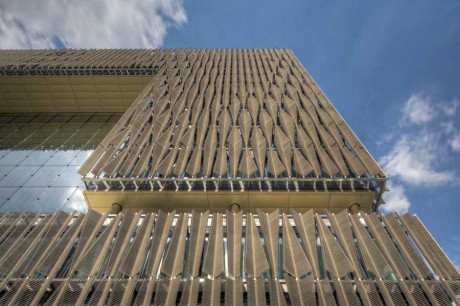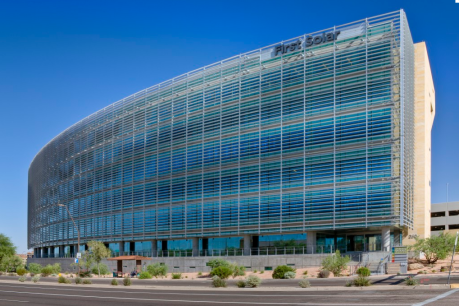This article is dedicated to buildings that incorporate adjustable/ movable technologies that can adapt to variations in climate and the position of the sun.
Jean Nouvel’s Arab Institute completed in 1987 is among the first buildings to employ sensor-based automated response to environmental conditions. 25,000 photoelectric cells similar to a camera lens are controlled via central computer to moderate light levels on the south facade (1). Now famously frozen in place, the apertures are commonly referenced in cautionary tails used to warn designers of the perils of developing kinetic facades.
The Gardens By The Bay by in Singapore by Wilkinson Eyre Architects features retractable fabric sails that are integrated into the exterior supports of the glass enclosed conservatory.
The Abu Dhabi Investment Council Headquarters design by Aedas architects and Arup engineers is shaded by a system of PTFE clad “Masharabiyas”. These function like giant umbrellas with a linear actuator located at the center of each.
108 kinetic fins make up the surface of the SOMA designed One Ocean, Thematic Pavilion EXPO 2012 located in Yeosu, South Korea. These fins or “lamellas” are supported at the top and bottom edges of the facade. The lamellas are composed of glass fibre reinforced polymers which gives them a high tensile strength, low bending stiffness and allows for large reversible elastic deformations. The kinetic facade was developed together with Knippers Helbig Engineers.

The recently completed Q1 headquarters building in Essen Germany is shaded by 3,150 kinetic “feathers” that open and close based on user input and sensor data.
The system of folding shades below is produced by Kiefer technic, a manufacturer of stainless steel medical equipment for their showroom in Bad Gleichenberg, Austria. The design was conceived by Giselbrecht+Partners.
……………………………………………………………………………………
Decker Yeadon is research based architectural practice that is currently developing several design applications for smart materials and nanotechnology. Among them are the Homeostatic Facade System and the Smart Screen featured below.
The non-mechanical nature of these systems sets their approach apart. Porosity of the surface is chemically inherent to the components and directly stimulated by heat or electric currents. For example, the Homeostatic Facade System is activated by heat when varied expansion by non-like materials causes the inner-layer to deform.
……………………………………………………………………………………
Hoberman and the Adaptive Building Initiative produce four kinetic systems: Tessellate, Permea, Strata, and Adaptive Fritting. ABI also teams with designers to create custom one-of solutions.
Chuck Hoberman gave a talk at UCLA this past December. Link to our blog post on the lecture and his work with the Adaptive Building Initiative here.
……………………………………………………………………………………
Sefar has developed several adaptable or retractable shades using a PTFE based membrane called Tenara . Tenara transmits more light and is more elastic then the more common fiberglass based PTFE membranes used in projects like the Abu Dhabi Investment Council HQ.
While privacy glass with user-controlled, variable opacity has been around for a while, there have been few viable offerings in the way of dim-able exterior glazing panels. Soladigm Dynamic Glass is based on electrochromic window technology developed at Lawrence Berkeley National Laboratory. Dynamic Glass can change its tint from clear to dark on demand and provide control over the amount of light and heat that enters a building. The manufacturer claims the product could deliver a 25 percent reduction in HVAC energy consumption and 30 percent reduction in peak load.

An existing to alternative Soladigm is Smart Glass produced by Sage Electrochromics.

……………………………………………………………………………………
……………………………………………………………………………………
Several automated louver based systems have also made their way into the market place. Colt offers a a series of automated glass and metal louver products as well as integrated PV / shading components. The system is shown below in the Papago Center Gateway located in Arizona designed by Smith Group.
Solormotion is a similar product from Construction Specialties (C/S) which offers multiple automation controls and various finishes. The system is shown below installed on the roof of the J. Paul Getty Museum in Los Angeles.

(1) Bosoni, Giampiero. Jean Nouvel. Geneve: Skira, 1999.








Hi. I am writing a thesis on kinetic facades. You referred to Jean Nouvel’s Arab institute as ‘frozen in time’, and the perils of kinetic design. Is there any references to this and what the issues are? I appreciate you help. Regards Pete
Hi Pete,
Admittedly, the statement that the facade system on the Arab Institute had ceased to function came from mostly first person accounts that I read while doing my own research online. There are basically three varieties:
1. It’s broken and because it was a one-off system, the panels are to expensive to repair and maintain.
2. The apertures work but adjust very slowly and its hard to tell the system is moving.
3. The apertures change position once an hour based on some kind of preset program. They are more of an attration and no longer photosensor controlled.
Take a look at the comments in the following articles for more info:
http://gizmodo.com/5641012/arab-centers-wall-is-alive-with-30000-mechanical-eyes
http://inhabitat.com/jean-nouvels-stunning-museum-facade-dilates-to-let-in-daylight/
If you happen to come across better information, please post it here and let us know!
Hi Yan. thank you for you response. I read a lot regarding this and needed to cite some definitive information in my paper. UnfortunateIy it has already been submitted, so i cited several online discussions on this (including your own) and one from a published online article relating to the Al Bahar Tower in Abu Dhabi, that has been inspired by the Arab institutes facade. Check it it out if you haven’t already done so. its quite impressive.
Article –
http://www.designbuild-network.com/features/featureclimate-control-intelligent-faades/
Images –
http://www.ctbuh.org/TallBuildings/FeaturedTallBuildings/FeaturedTallBuildingArchive2012/AlBaharTowersAbuDhabi/tabid/3845/language/en-US/Default.aspx
Thank you again
Pete
[…] tra cui il fallimento di attrezzature e parti rumorosi, così per anni la facciata è rimasta statica . Non c’è nulla di “misterioso” e “profonda” circa le finestre […]